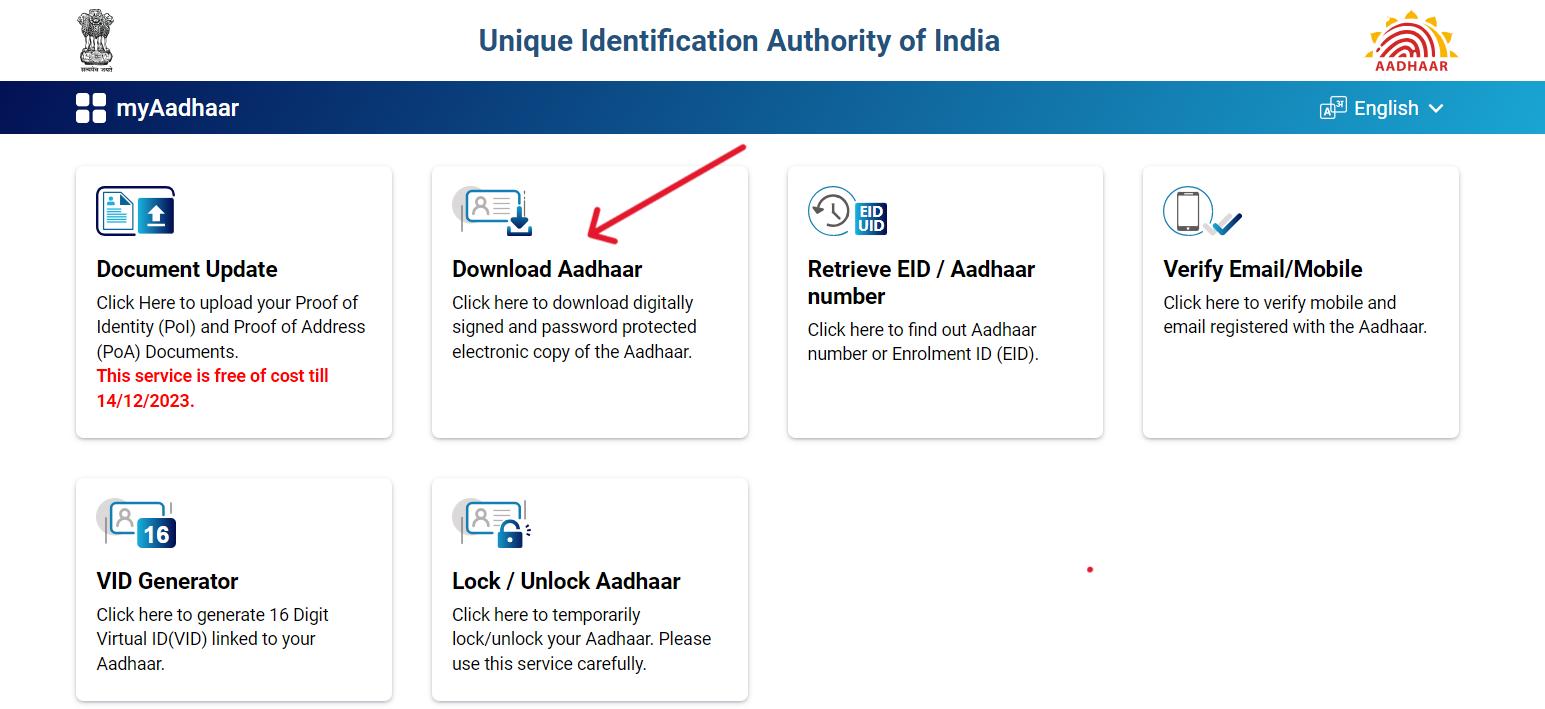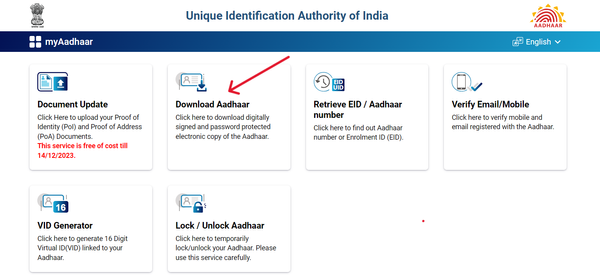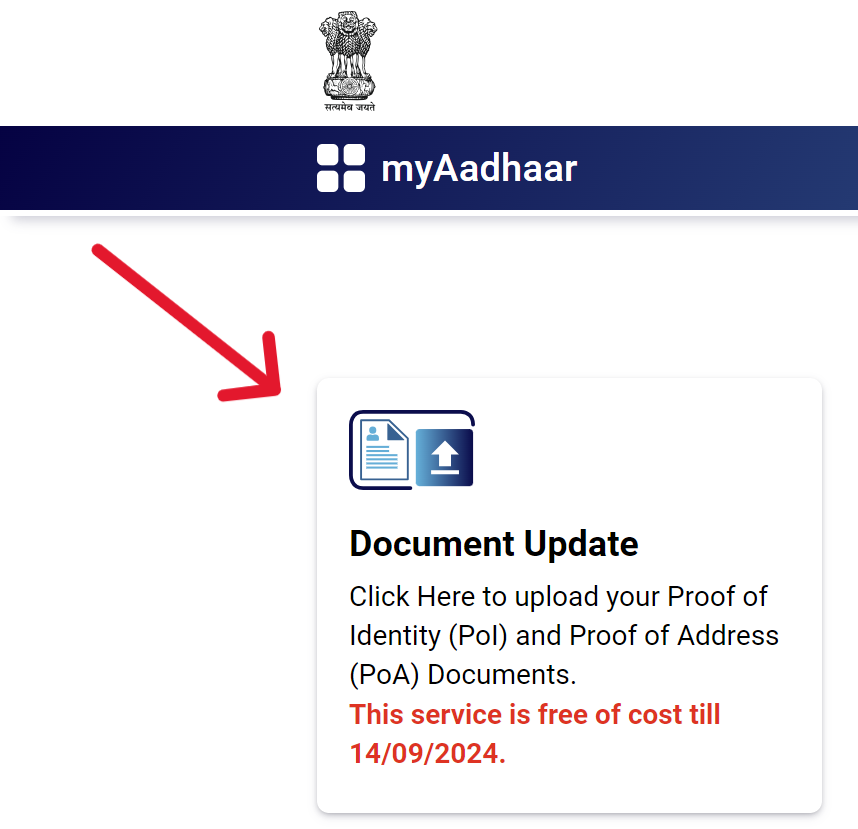
Aadhaar
Aadhaar is a 12-digit unique identity number available to all residents of India. It's based on biometrics (fingerprints, iris scans, and a picture of the person) and demographic data.
It's used for identification, banking, and accessing various government services. Aadhaar is the world's largest biometric ID system, managed by the Unique Identification Authority of India (UIDAI).
On this webpage, you can get detailed information about Downloading, Updating, Checking the Status, Retrieving of Aadhaar.
Download
Here is a step-by-step guide to downloading the Aadhar.
- First, go to the official website: https://myaadhaar.uidai.gov.in/.
- Then, click on the "Download Aadhaar" link.

- On the "Download Aadhaar" page, you are required to choose an authentication method between Aadhaar Number, Enrollment ID, and Virtual ID.
- Enter Aadhaar Number/Enrollment ID Number/Virtual ID Number and captcha, then click on "Send OTP".
- An OTP will be sent to your registered mobile number.
- Enter OTP and click on "Verify and Download"; after that, the Aadhaar will start downloading on your device.
Update Aadhaar
Here is the step-by-step guide to update Aadhaar card:
- First, go to the official website: https://myaadhaar.uidai.gov.in/.
- Click on “Update Aadhaar” to update your Aadhaar information.

- Now, click on the "Click To Submit" option.
- On the new page, you should log in using your Aadhaar number and the captcha provided.
- Then, select the data you wish to update and click on ‘Proceed’.
- On the next page, upload the proof related to the data changes you have made.
- Confirm the information you have changed once again and click on submit.
- A few days after submission, your Aadhaar correction update will be processed, which you can check by downloading your Aadhaar card.
Check Aadhaar Status
Here is the step-by-step guide to check Aadhaar card status:
- First, go to the official website: https://myaadhaar.uidai.gov.in/.
- Now, click on the "Check Enrolment & Update Status" option available on the homepage.

- On the "Check Enrolment & Update Status" page, you are required to choose an authentication method between Enrollment ID, SRN, and URN.
- Enter all the necessary details and the captcha code, then click on the 'Submit' button.
- After this, your Aadhaar Card Status will be displayed on your screen.
What is Aadhaar?
Aadhaar is a comprehensive identity system initiated by the Indian government, represented by a unique 12-digit number assigned to each resident of India. This unique identifier that records an individual's biometric (10 fingerprints, 2 iris scans, and facial photograph) and demographic data, which are stored in a secure centralized database.
Aadhaar is the world's largest biometric ID system, was launched on January 28, 2009, and is managed by the Unique Identification Authority of India (UIDAI), under the Ministry of Electronics and Information Technology.
Purpose/Benefits
- Identification: It provides a unique 12-digit number linked to an individual's biometrics, serving as a universal identity proof across India. It helps in eliminating duplicate and fake identities.
- Direct Benefit Transfer (DBT): Aadhaar ensures that government subsidies and benefits are directly transferred to the correct beneficiary's bank account, reducing fraud and improving efficiency.
- Insurance: Using Aadhaar accelerates the KYC process for obtaining insurance, reducing paperwork and fraud, and making insurance more accessible to a broader population.
- Bank Account: Aadhaar simplifies the process of opening bank accounts by serving as a comprehensive KYC document, promoting financial inclusion by allowing more people to access banking services.
Criticism and Concerns
Despite the numerous advantages of Aadhaar, there are certain criticisms and concerns regarding it, which are outlined below.
Fraud
Despite Aadhaar's design to prevent identity fraud, there have been instances where the system was manipulated. Fraudulent activities have included the creation of fake Aadhaar numbers and the unauthorized use of biometric data.
Critics argue that these incidents highlight vulnerabilities in the Aadhaar system, potentially enabling identity theft and financial fraud. Concerns have been raised about the ease with which Aadhaar data can be misused to open bank accounts or obtain SIM cards, leading to financial and personal security risks for individuals.
Data Leaks and Security Issues
Aadhaar has faced significant scrutiny regarding data security and privacy. There have been several reported instances of Aadhaar data leaks, exposing personal information on millions of individuals.
These leaks raise concerns about the robustness of the data protection measures in place and the potential for widespread privacy violations.
Critics argue that the centralized nature of the Aadhaar database presents a high-value target for cyber-attacks and unauthorized access, putting the personal and biometric data of Indian residents at risk.
Judgment
In 2018, the Hon'ble Supreme Court of India delivered a landmark judgment on Aadhaar, addressing its constitutional validity and usage. Key highlights of the ruling are:
- Constitutional Validity: The Court upheld the Aadhaar system's constitutionality, recognizing it as a tool for empowering marginalized sections of society by enabling access to various government subsidies and welfare schemes.
- Limited Mandatory Use: The Court ruled that Aadhaar could be mandatory for availing government subsidies and welfare schemes funded from the Consolidated Fund of India. However, Aadhaar cannot be required for services such as:
- Opening bank accounts
- Getting a mobile SIM card
- School admissions or exams like CBSE, NEET, and JEE.
- Privacy Protection: The Court highlighted that Aadhaar does not violate the right to privacy, provided there are robust security measures in place. It mandated UIDAI to maintain data privacy and security, restricting the use of biometric data for authentication purposes only.
- Section 57 Struck Down: The Court invalidated Section 57 of the Aadhaar Act, which allowed private companies and other entities to use Aadhaar authentication. As a result, companies like telecoms and banks cannot make Aadhaar mandatory for their services.
- Retention of Data: The Court directed UIDAI to reduce the retention period for authentication data from five years to six months.
Overall, the 2018 ruling struck a balance between Aadhaar's utility for welfare schemes and the protection of individual privacy, placing limits on its mandatory usage outside of government benefits.
Precautions
- Avoid leaving your Aadhaar letter, PVC Card, or any copies of them unattended.
- Refrain from sharing your Aadhaar details openly, especially on social media platforms like Twitter, Facebook, Instagram, etc., and other public forums.
- Do not disclose your Aadhaar OTP (One-Time Password) to any unauthorized individuals or entities.
- Use a masked Aadhaar to hide the first eight digits for secure verification.
- Never share your mAadhaar application PIN with anyone.
What is e-Aadhaar?
e-Aadhaar is a digital version of the Aadhaar card, which is an official, electronically signed document issued by the Unique Identification Authority of India (UIDAI).
It is as valid as the physical Aadhaar card and contains all the necessary details such as the Aadhaar number, photograph, and demographic information. This digital format ensures easy accessibility, portability, and convenience in carrying and sharing Aadhaar information securely.
What is UIDAI?
The Unique Identification Authority of India (UIDAI) is a statutory authority established under the provisions of The Aadhaar (Targeted Delivery of Financial and Other Subsidies, Benefits and Services) Act, 2016.
It was set up by the Government of India in January 2009 and operates under the Ministry of Electronics and Information Technology. The UIDAI's mandate is to issue a unique 12-digit identification number, known as Aadhaar, to all residents of India.
Key Functions and Responsibilities
- Issuance of UID Numbers: UIDAI is responsible for the generation and assignment of the unique Aadhaar numbers to Indian residents, which are linked to the individual's basic demographic and biometric information.
- Data Security and Management: The authority manages a centralized database that stores all the collected biometric and demographic data securely.
- Policy and Protocol Development: UIDAI develops policies, procedures, and systems for issuing Aadhaar numbers, updating resident information, and authenticating Aadhaar holders.
- Interlinking with Partner Databases: It defines mechanisms and processes for linking Aadhaar numbers with partner databases to streamline and secure service delivery.
- User Authentication: UIDAI provides an online platform for various agencies to authenticate the identity of Aadhaar holders as required for service provision.
Infrastructure and Operations
The UIDAI's data centers are located in Manesar and Bengaluru, housing around 7,000 servers to manage and protect the vast amount of data processed.
Since its inception, the UIDAI has aimed to ensure that Aadhaar numbers are robust enough to eliminate duplicate and fake identities and can be verified and authenticated in a cost-effective manner, anytime and anywhere.
The UIDAI plays a crucial role in improving service delivery and transparency in government and non-government services, contributing significantly to the digital infrastructure of India.
Vision
The UIDAI envisions empowering residents of India with a unique identity and a digital platform to authenticate themselves anytime, anywhere. This vision aims to provide a secure and inclusive environment that facilitates identity verification and enhances access to various services and benefits.
Composition of UIDAI AuthorityChairperson (Part-time)Neelkanth MishraCEOAmit AgrawalTwitterFacebookInstagramOfficial WebsiteFrequently Asked Questions
Below, you can find frequently asked questions and their answers.
Read FAQs
Link nội dung: https://melodious.edu.vn/vuihai-a59624.html